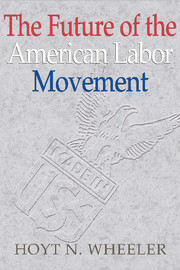Book contents
- Frontmatter
- Contents
- Foreword
- Introduction by Lynn R. Williams
- 1 A Future for the American Labor Movement?
- 2 Industrial Relations in a Time of Change
- 3 A Survey of American Union Strategies
- 4 The Old Reformist Unionism: The Noble Order of the Knights of Labor
- 5 The New Reformist Unionism: CAFE
- 6 A New Version of an Old Reformist Strategy: Employee Ownership
- 7 Social Democratic Unionism in Action: Strategies of European Trade Unions
- 8 A New Twist and TURN on Social Democratic Unionism: Unions and Regional Economic Development
- 9 A Labor Movement for the Twenty-First Century
- Appendix: Interview with John J. Sweeney, President, AFL-CIO
- References
- Index
Introduction by Lynn R. Williams
Published online by Cambridge University Press: 06 July 2010
- Frontmatter
- Contents
- Foreword
- Introduction by Lynn R. Williams
- 1 A Future for the American Labor Movement?
- 2 Industrial Relations in a Time of Change
- 3 A Survey of American Union Strategies
- 4 The Old Reformist Unionism: The Noble Order of the Knights of Labor
- 5 The New Reformist Unionism: CAFE
- 6 A New Version of an Old Reformist Strategy: Employee Ownership
- 7 Social Democratic Unionism in Action: Strategies of European Trade Unions
- 8 A New Twist and TURN on Social Democratic Unionism: Unions and Regional Economic Development
- 9 A Labor Movement for the Twenty-First Century
- Appendix: Interview with John J. Sweeney, President, AFL-CIO
- References
- Index
Summary
There is no subject of more compelling interest and concern to those who care about working people and their unions, than to consider the future of the American labor movement. In this volume Professor Wheeler presents us with a most thoughtful and comprehensive review and analysis of how the present difficult circumstances came to be, including an intriguing look at some historical precedents and an innovative, inclusive, and wide-ranging set of ideas and proposals about how a positive future might and indeed will unfold.
There can be no doubt that recent decades have been difficult for the American labor movement. The statistics are familiar, presented most frequently in terms of the decline in union density, that is, in the reduced percentage of eligible workers represented by unions, from a peak of 32.5 percent in 1953 to the present percentage of approximately 13.5 percent. Of course there are an array of subordinate statistics in and around these overall numbers showing the percentage of representation to be much higher in the public than the private sector; the enormous growth in the service sector outstripping in sheer volume labor's many effective organizing efforts with and among service workers; the decline of manufacturing and, therefore, much of labor's base; and the relative lack of unionization in the new economy.
- Type
- Chapter
- Information
- The Future of the American Labor Movement , pp. xiii - xxPublisher: Cambridge University PressPrint publication year: 2002



